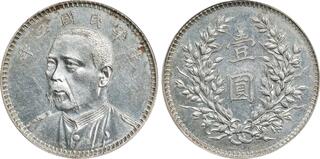Lot description:
CHINA. Silver Dollar Pattern Mint Sport or Unofficial Restrike, Year 3 (1914). Tientsin Mint Dies. UNCIRCULATED Details. Cleaned.
L&M-72; K-643; KM-Pn32; WS-0166; Wenchao-pg. 534#858 (rarity: ★★★); Mr. Shi Jiagan's collection-pg. 137#633; Sun-III-2-15. Weight: 24.83 gms. One of the most enigmatic issues of this Pattern we have every offered, with this piece likely representing a later made mint sport or unofficial striking of the three-quarters facing bust Pattern (L&M-72), made with official dies. Interestingly, this coin is not alone in this class of striking, and after study of other examples, this piece can be definitively linked to other certified examples of L&M-72 as well as the L. Giorgi signed patterns (L&M-73). Common characteristics include double striking, which is particularly bold on this example, and surfaces that display an as-made micro pockmarked texture. Most definitively, items in this class (both L&M-72 and L&M-73) were struck with the same reverse dies, each showing matching instances of die rust, which is heaviest near the top left tip of the 'yi' character. While it's almost certainly not a complete census, other examples in this class include lot 30193 in Heritage's December 2020 auction (L&M-72 - NGC MS-63), lot #51170 in our October 2022 Hong Kong sale (L&M-73 - NGC PR-61), and lot #51145 from our May 2022 auction (L&M-73 - NGC MS-61), which was once part of the collection of Richard Wright who authored The Modern Coinage of China, 1866-1949.
Characteristics explored, it seems certain their manufacture from rusted dies ensures they were originals from the mint, however the quality of production suggests an unofficial or unsponsored piece. In fact, weighing this example yields a disparity of nearly 2 grams lighter than official issues (24.83 gms versus a standard of nearly 27 gms), which further supports the hypothesis of an unofficial strike or mint sport. Kann relays that mint sports were often the product of government minting facilities using official dies such as the present example. Because mint sport items were often a muling of different types, they are easy to distinguish, however examples are known to be struck over earlier dollars or display similar pockmarking of the surfaces, which helps draw a parallel between this piece and those classically identified as mint sport. Given these considerations, it is a fair summation to view this piece as a quasi-legitimate Pattern, produced with old original dies, on incorrect silver planchet stock.
As far as the technical preservation of the piece, it remains nice, without wear but displays moderate handling in the form of hairlines. The surfaces give a soft glittering glow and a few instances of light tone. While it isn't a great surprise considering the enigmatic nature of this piece, we note that both PCGS and NGC have declined to encapsulate it, PCGS for "Authenticity Unverifiable" and NGC for "No Decision". As such, this issue must be treated as a SOLD AS IS/NO RETURNS lot. Despite the grading company decisions, we do believe that this example represents an intriguing and interesting Chinese numismatic item that raises questions of "when" and "why", but of which there is little dispute concerning the legitiamacy of the dies from which it was made. To view all items from the Nine Dragons Collection, click here.
From the Nine Dragons Collection.
Estimate: $5000 - $10000 |  |